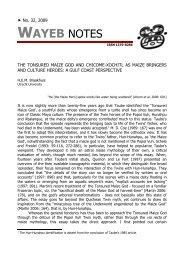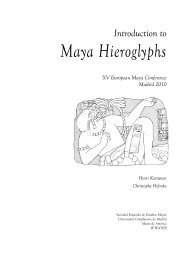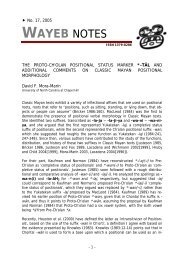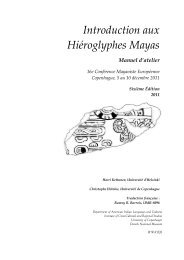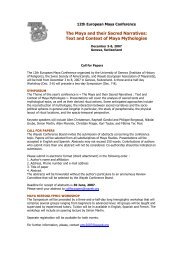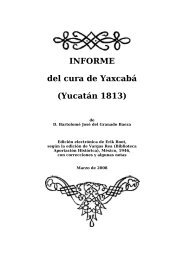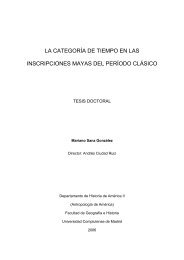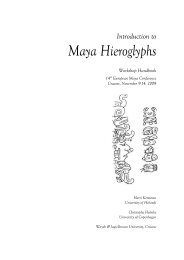Introduction to Maya Hieroglyphs - Wayeb
Introduction to Maya Hieroglyphs - Wayeb
Introduction to Maya Hieroglyphs - Wayeb
You also want an ePaper? Increase the reach of your titles
YUMPU automatically turns print PDFs into web optimized ePapers that Google loves.
Kettunen & Helmke 2011<br />
Structure and Content of Texts<br />
Figure 14: Page 6 from the<br />
Paris Codex<br />
(after<br />
Codex Peresianus (Codex<br />
Paris) 1968)<br />
Figure 15: Page 8 from<br />
the Grolier Codex<br />
(after Coe and Kerr 199<br />
8: Fig. 134)<br />
Figure 16: Bot<strong>to</strong>m of the<br />
page<br />
56 from the Madrid<br />
Codex (rotated 90 degrees<br />
counter-clockwisee and<br />
flipped horizontally)<br />
showing Latin text<br />
(after Codex Tro-<br />
Cortesianus<br />
(Codex Madrid) 1967)<br />
20. PORTABLE ARTEFACTS<br />
The inscriptions on portable artefacts, like shell, bone, jadeite beads, etc. are – logically – a lot shorter than the<br />
texts on the monuments. Many small artefacts just state the owner and the name of the object; for example (see<br />
Figure 17): ubaak jasaw t’ochawaan? k’uhul mutul ajaw ochk’in kalomte’ umijinil nu’n ujol chahk<br />
k’uhul mutul ajaw (“this<br />
is the bone of Jasaw, t’ ’ochawaan?, divine Mutul king, west kalomte’, the child of Nu’n Ujol Chahk, divine Mutul<br />
king”), but some have lengthier texts with verbal clauses. These simple statements of ownership are sometimes<br />
referred <strong>to</strong> as ‘name-tagging’.<br />
Figure 17: Carved bone from Burial 116, Tikal (TIK MT-44);<br />
Drawing by Chris<strong>to</strong>phe Helmke (based on drawing by Annemarie Seuffert)<br />
39/154



